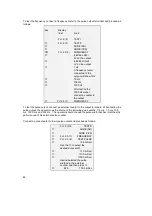
79
8.1.2 Testing current output
This function allows a number of fixed current levels from 0 to 22 mA to be driven from the
current output. This function interrupts the normal operation of the output, so the operator will
be asked if he is sure before the test commences.
Press the
↵
key at any time to stop the test and return the output to normal operation.
Systems with two or more current outputs
From software P2.14 onwards programming of any current output will be by menus Fct. 1.3.0
and Fct. 3.3.0 (testing will be by menu Fct. 2.2) regardless of how many current outputs are
fitted. When programming (or testing) a system with two current outputs the operator must
first select the desired output number.
Fct. 3.(3).0
CUR.OUT.I
→
Fct. 3.3.0
CUR.OUT.I(1)
↑
Fct. 3.3.0
CUR.OUT.I(2)
Use the
↑
key to select the
desired output number
↵
Fct. 3.3.(1)
FUNCTION I
Program the selected output
as normal
8.1.3 Testing pulse output
This function allows the frequency/pulse output to be tested. The frequency output has an
open collector transistor drive which requires a pull-up resistor to an external DC power
supply. (Sect. 3.3). When this output is connected to the customer’s instrumentation, reliable
operation can only be ensured if the customer takes proper care to ensure the connection is
properly screened against external electrical interference. Therefore, it is important that this
output connection should be thoroughly tested before being put into use.
Key
Display
line 1
line 2
Fct. 2.(1)
TEST DISP.
↑
Fct. 2.(2)
TEST I
→
SURE (NO)
↑
SURE (YES)
↵
(0 mA)
0 mA is output
↑
(2 mA)
↑
(4 mA)
↑
(10 mA)
↑
(16 mA)
↑
(20 mA)
↑
(22 mA)
↑
(0 mA)
















































